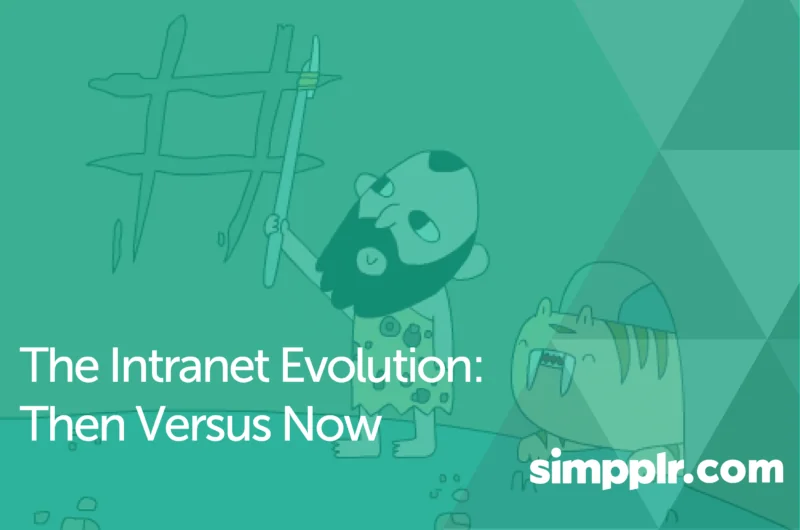For many organizations, the intranet is an afterthought. Styles and designs are outdated by several years, and the site serves as a repository for basic information.
Even companies that publish regular updates are not making the most of this tool. They keep information high-level, with very little personalization. Antiquated technology makes it difficult to add permissions, and when the few people with administrative access are busy with other projects, the pages gradually go stale.
In traditional workplaces complete with offices, cubicles and water cooler chats, an obsolete intranet isn’t necessarily a problem. Colleagues develop relationships and exchange information in person through informal conversation and chance hallway meetings. However, much of the working world is going virtual, and organizations without a central location to get information and make personal connections struggle with employee engagement and productivity levels. Staff members feel isolated, as they lack the camaraderie that comes with seeing colleagues every day.
Advances in technology are transforming how intranets are used, and new tools are making it possible for employees to enjoy meaningful work relationships — even if they never step foot on-site. Through use of software that is similar in look and feel to popular social media sites, employees easily make personal connections with co-workers and business leaders.
Signs of an Outdated Intranet
IT professionals and business leaders often disagree on whether current systems are sufficient. Outlining the signs of an outdated intranet platform can assist in illustrating the need for change. Some specific issues with legacy platforms include the following:
- Poor user experience — These platforms are difficult to navigate, and search functions fail to return needed results. Typically, they are not visually appealing and lack a modern feel.
- Lack of flexibility — One of the hallmarks of legacy platforms is their rigidity. The structure is difficult or impossible to change, and the companies using these platforms must fit their content into existing parameters.
- Foundation — Many of the older solutions got their start as on-premises systems. Though most have transitioned to new cloud-based technology, their heritage continues to impact functionality. Some of the most frustrating issues include an inability to integrate smoothly with other software.
- Maintenance and support — Legacy platforms require significant involvement from IT staff, as very little maintenance and issue resolution is possible from the user side. Managing older intranets is time-intensive, using resources that would be better deployed elsewhere.
- Mobile optimization — Despite the prevalence of mobile devices, most of the older intranet platforms are not optimized for mobile, and they do not offer a mobile app. This is a serious drawback, as most employees rely on mobile devices to stay connected with the workplace.

How Intranet Platforms Have Evolved
Many of the modern intranet platforms were built from the ground up, incorporating the most recent technology every step of the way. The resulting products mesh with common business software, and they mirror the user experience of popular applications. When presenting a solution to business leaders, these points are quite persuasive:
- Intuitive user experience — Because the newer platforms were designed from scratch, developers could take current work habits into consideration. The employee experience is carefully designed with consideration for how work is completed, and the platforms look and feel state of the art.
- Adaptability — Advanced intranet platforms are customizable, with easy-to-use point-and-click configurations. As a result, they can be tailored to the specific business needs of an entire organization, department or team.
- Foundation — Because the new platforms were originally created as cloud-based systems, they are fully integrated with cloud-based storage and delivery features. Most are SaaS, which simplifies implementation considerably.
- Maintenance and support — One of the most appealing features of advanced intranet technology is its self-sufficiency. These systems can be implemented in just a few weeks, and they require little or no subsequent IT support. Instead, business users have complete autonomy in managing the system, making it possible to create a deep, rich library of content and employee-centric features.
- Mobile optimization — Newer platforms are designed with users in mind, which means that users can move seamlessly between laptops and mobile devices. This feature encourages wider adoption and increased productivity among employee users.
The best social intranet software platforms do more than simply provide space for corporate and department news. They have features specifically intended to encourage personal connections and collaboration in the workplace among co-workers. For example, these platforms include in-depth employee directories as well as personal profile pages, timelines, alerts and blogs. Team leaders and managers can produce local newsletters, and search functions are sophisticated enough to pinpoint requested information quickly and accurately. Companies that adopt such platforms boast 100 percent usage among staff members, and in many cases, employee engagement levels increase as workers feel more connected to the company and to each other.
Organizations that still rely on legacy systems for communication and collaboration are facing significant missed opportunities. Isolation of virtual workers and staff frustration with slow, outdated software can lead to lower productivity and disengagement. Eventually, disengaged employees move on to other companies, taking their skills and talents to a digitally focused culture where they feel more comfortable.

















